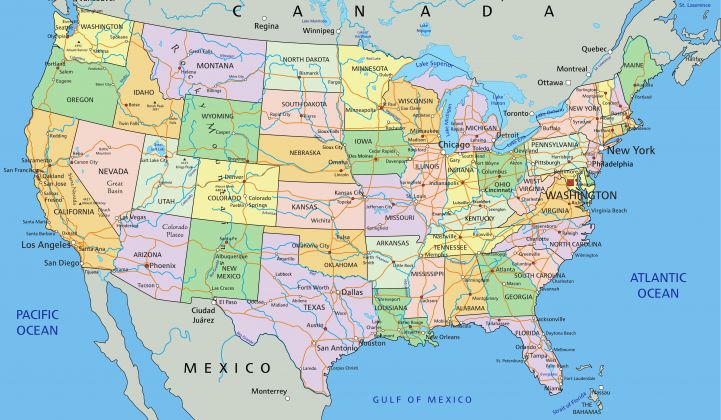It’s easy to focus on states where the burgeoning commercial energy storage markets are already thriving.
“Everyone knows California and New York are ripe,” said Ravi Manghani, GTM Research’s director of energy storage.
But there are some sleeper states where the economics already work, even though rates of adoption are low. A new report from GTM Research, The Economics of Commercial Energy Storage in the U.S, outlines the states where demand charges at the largest utility in each state would create a favorable rate of return for commercial energy storage. Even if the numbers pencil out, however, there can be other factors that help or hinder behind-the-meter energy storage, from fire codes to utility regulation.
Today, the pure demand-charge economics work in seven states that all provide an internal rate of return over 5 percent. You might be surprised at which states round out the list topped by California and New York.

Kentucky
“You might expect the only kind of storage in Kentucky would be for bourbon,” said Manghani, but you’d be wrong. For example, Kentucky municipal utility Glasgow EPB is using Sunverge's energy storage systems to reduce peak demand.
As for the state’s largest utility, Kentucky Utilities, which serves more than 500,000 customers, peak demand charges are about $19 per kilowatt for small and medium-sized commercial customers. That gives a rate of return on a 1-hour system of roughly 13 percent, and 9 percent for a 2-hour system. By 2021, GTM Research is forecasting a rate of return for small commercial customers in KU territory of 25 percent, the third-best payback of any state’s biggest utility.
Even with the solid rate of return now, the commercial energy storage industry in Kentucky remains practically nonexistent. That could change, however. The Federal Energy Regulatory Commission recently rejected a proposal by Maysville Pumped Storage for a 1,000-megawatt pumped storage project to be located in Mason County. There is a possibility that some of the grid needs for storage could be met in part by behind-the-meter commercial systems.
Connecticut
Connecticut is on the cusp of providing an internal rate of return high enough to justify storage. To get a rate of return of at least 5 percent, demand charges have to be at least about $15 per kilowatt, according to the report. And Connecticut Light & Power has a demand charge of about $15 per kilowatt.
Connecticut has some other factors going for it, including an RFP from the state for energy storage systems, renewables and customer-sited combined heat and power. For this RFP, however, energy storage projects smaller than 1 megawatt may not be aggregated, except for behind-the-meter thermal storage, which will be treated as passive demand response.
Although there has been relatively little commercial energy storage in Connecticut so far, the state’s interest in microgrids could also help build the market for distributed energy storage.
Delaware
Delaware is another state with an interest in distributed energy systems for increased resiliency. Earlier this year, the state approved its Solar Resiliency Pilot Program to install solar-plus-storage at public or non-profit emergency response facilities and school districts, according to Manghani.
Unlike Connecticut, it has already seen a bit more action. Sunvault Energy and Edison Power have signed a deal for solar-plus-storage at three fire stations. Earlier this year, Alveo also announced it will install an energy storage system for the City of Lewes. For commercial clients of Delmarva Power, the peak demand is slightly higher than Connecticut, but the internal rate of return is the same for large commercial customers with 1-hour systems, at about 5 percent.
Massachusetts
The Bay State is probably the least surprising entry on the list. “Of all the states in this quintet, Massachusetts is furthest along on storage deployments and policy support,” said Manghani.
The state launched an energy storage initiative that allocates $10 million for pilot projects. There will also be more projects funded through community resiliency efforts. The state senate has also proposed a storage mandate.
As for demand-charge management, Eversource, the state’s largest utility, has peak demand charges that would offer an 11 percent return on 1-hour energy storage systems for both small and large commercial customers, and a 7 percent internal rate of return on 2-hour systems.
New Hampshire
Like some other Northeast states, New Hampshire has also issued a docket on regulatory reform to achieve more grid reliability and flexibility, with a focus on more distributed energy resource integration and better use of demand-side resources.
“Though energy storage is not specifically mentioned in the docket, given similar proceedings in states like Massachusetts and New York, GTM Research expects energy storage to be a component of New Hampshire’s future grid modernization plan,” said Manghani. Today, the economics only pencil out for small commercial customers at the state’s largest utility, Public Service Company of New Hampshire, where peak demand charges would offer a 6 percent internal rate of return for 1-hour systems.
***
For more information on GTM's commercial energy storage report, download the brochure.



